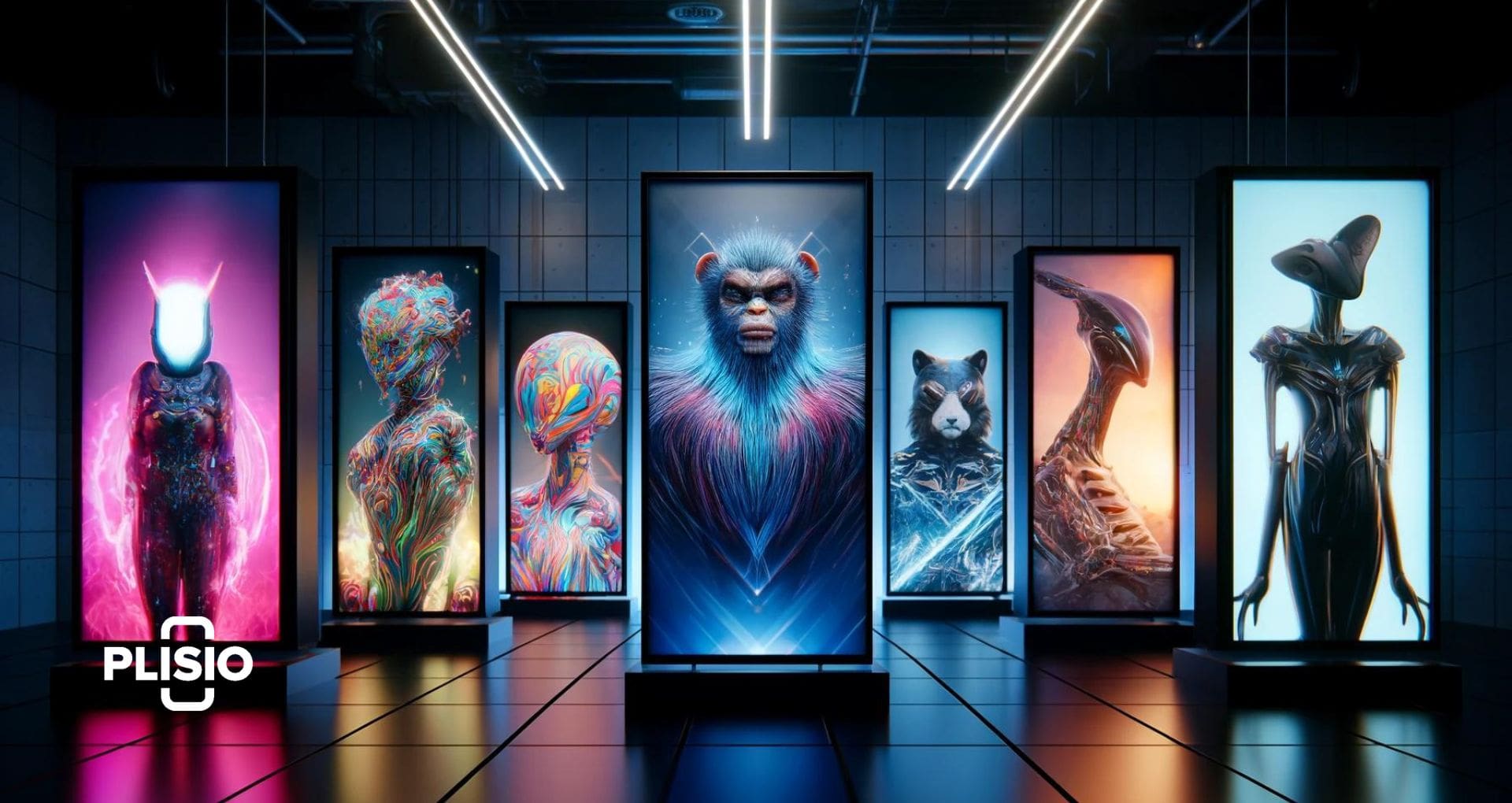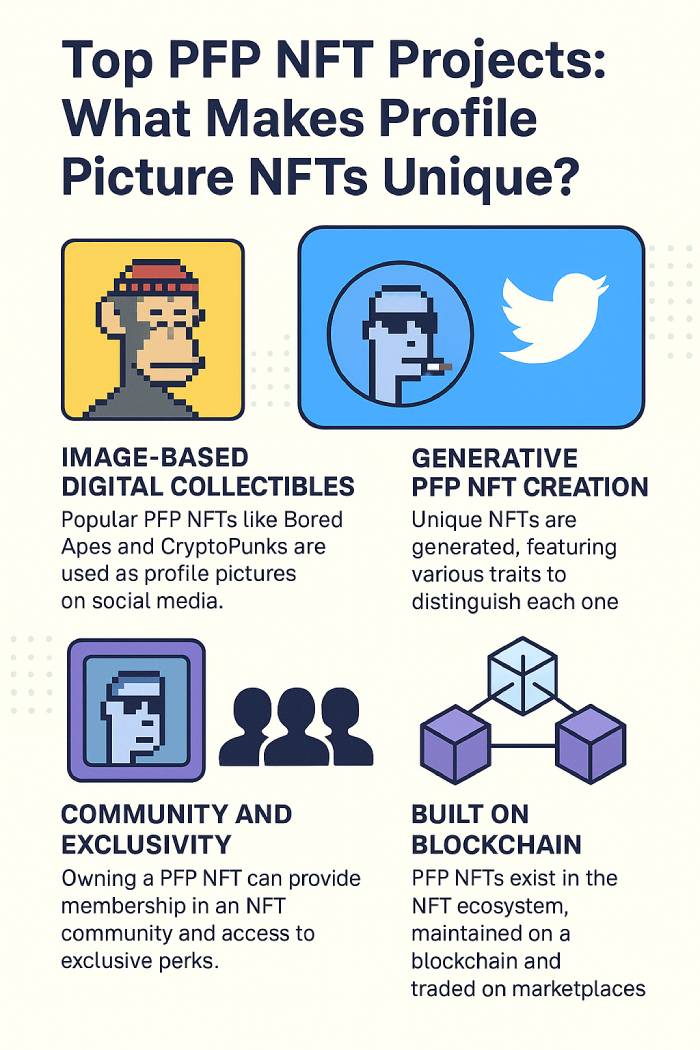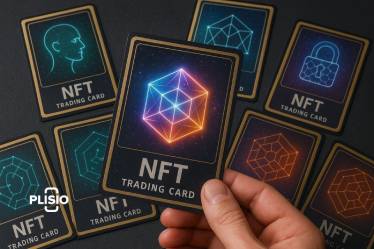Top PFP NFT Projects: What Makes Profile Picture NFTs Unique?

In 2021, Profile Picture (PFP) NFTs, such as Bored Apes and CryptoPunks, took the internet by storm, frequently appearing as social media avatars. Originally just quirky images for online profiles, these NFTs have evolved into highly sought-after digital collectibles within the NFT community. When you hear the term PFP NFT, it’s not just a random jumble of letters; it signifies a specific type of non-fungible token used primarily as profile pictures on platforms like Twitter. Celebrities often flaunt their elite Bored Ape Yacht Club NFTs as their chosen avatars. However, these profile pictures represent more than just social media identities; they are part of a broader digital ecosystem that revolves around image-based NFTs, merging digital art with online persona management.
What Defines a PFP NFT Collection?
Profile Picture (PFP) NFTs, primarily showcased as avatars on social media platforms like Twitter and Discord, represent a unique blend of digital artistry and personal identity. Most PFP NFTs are computer-generated artworks, but the space also embraces hand-drawn collections. These collections often feature thousands of NFTs, each depicting unique characters such as apes, cats, or humans, distinguished by various traits to ensure no two are exactly alike.
The PFP NFT concept was pioneered by CryptoPunks, an innovative project launched by Larva Labs in 2017. Founded by Matt Hall and John Watkinson, CryptoPunks introduced thousands of randomly generated pixel art images, known as 'Punks', which quickly became status symbols among celebrities and web3 enthusiasts. Each Punk has distinct, fun personalities that resonate with their owners, adding a personal touch to the digital tokens.
Initially, Hall and Watkinson issued CryptoPunks as standard ERC-20 tokens with modifications to prevent fractional trading, a precursor to the more specialized ERC-721 standard now prevalent in the NFT market. This standardization has been critical in distinguishing NFTs from other types of cryptocurrency tokens, focusing on their uniqueness and ownership.
The overwhelming success of CryptoPunks not only catalyzed the popularity of PFP NFTs but also inspired subsequent projects like Meebits, which introduced 3D characters into the NFT space. As of April 2022, the entry price for a CryptoPunk was around 62 ETH (over \$180,000), indicating the high value and demand for these original digital collectibles. As of mid-2025, the average floor price of CryptoPunks has decreased to around 30 ETH, reflecting a more stabilized and mature NFT market.
Following in the footsteps of CryptoPunks, the Bored Ape Yacht Club (BAYC) emerged as another massively popular PFP NFT collection. As of Q2 2025, BAYC maintains one of the highest market capitalizations among PFP NFT projects, valued at approximately \$420 million, according to NonFungible.com.
Dr. Maya Lang, a digital assets analyst at ChainMetrics, notes, "The current valuations of PFP NFTs reflect both their artistic and social capital. Their use as online identity markers makes them unique among digital assets."

How PFP NFTs Work on Blockchain: From Minting to Marketplaces
PFP NFTs, or Profile Picture Non-Fungible Tokens, function on public blockchains, each characterized by a fixed supply, a transparent transaction history, and provable scarcity, ensuring their uniqueness and value. The majority of these tokens are hosted on the Ethereum blockchain, adhering to the ERC-721 standard, which is widely recognized for enabling the tracking and trading of individual digital items. Additionally, 2023 saw the rise of popular avatar collections on alternative chains, like the Bitcoin Ordinal collection and Taproot Wizards.
As of 2025, Ethereum still hosts over 80% of all NFT-related activity, while Solana and Bitcoin-based Ordinals account for growing shares of the market, with Solana NFT volume increasing by 23% year-over-year.
If you're looking to use a PFP NFT as your social media avatar, you can either mint one directly from a project's official website or purchase one through NFT marketplaces like OpenSea or SuperRare. OpenSea remains the most widely used NFT marketplace in 2025, with over 2.1 million active users monthly. Once acquired, displaying your NFT on social media is straightforward: simply download the image file of your NFT and upload it as your profile picture. While it’s not necessary to use a platform that integrates NFTs directly with your account, if you are a Twitter user with a Twitter Blue subscription, you can link Ethereum-based NFTs directly to your profile, showcasing your digital asset to your network.
Why Profile Picture NFTs Are a Leading Trend in the NFT Market
The phenomenon of PFP (Profile Picture) NFTs gained momentum following the breakthrough success of CryptoPunks in 2017, with their popularity skyrocketing during the 2021 market boom. This surge was notably influenced by Beeple's landmark \$69 million NFT sale in March 2021, which not only highlighted the financial potential of NFTs but also solidified PFP NFTs as symbols of wealth, fame, and digital savvy.
In 2025, over 37% of NFT collectors identify PFP NFTs as their favorite category, and nearly 60% of NFT-related social media avatars feature PFPs, based on recent surveys by DappRadar.
According to Emma Collins, Head of NFT Strategy at DigitalEra Group, "PFPs have transcended their initial purpose. They’re not just art—they’re identity, access, and influence rolled into one."
One of the key appeals of PFP NFTs lies in their role as social tokens, allowing collectors to showcase their membership within specific communities. These NFTs are more than digital assets; they offer prestige and inclusion in exclusive circles, often accompanied by tangible benefits. For instance, holders of Bored Ape Yacht Club NFTs enjoy access to private events, exclusive merchandise, and other community-specific advantages.
Furthermore, the leading PFP NFT projects typically present a well-defined roadmap of future activities and expansions, reinforcing investor confidence in their sustained relevance and long-term value. This forward-looking approach ensures that PFP NFTs remain at the forefront of digital collectible trends.
What Sets PFP NFT Collections Apart From Other NFT Projects?
PFP NFT collections stand out from other types of non-fungible tokens primarily because they are crafted specifically to serve as profile pictures on social media and various online platforms. Unlike other NFTs that may represent tangible assets, in-game items, or virtual real estate, PFPs are generally 2D images curated to enhance an online persona.
Additionally, PFP NFTs allow collectors to display the rarity and exclusivity of their holdings, attributes that often translate into higher prestige and value. The more unique and scarce an NFT is, the greater the status it confers on its owner and the higher the price it can command in the market.
The allure of PFPs extends beyond mere display of wealth or status; many people are drawn to them as a means of connecting with others who share similar interests, creating a sense of community and belonging. Whether used as a statement of identity or as part of a larger digital collection, PFP NFTs offer a novel and engaging way for individuals to express themselves in the digital realm, cementing their place as a lasting trend in the evolving world of online interaction.
Twitter’s Role in Verifying NFT Profile Pictures and Boosting PFP Adoption
Twitter solidified the link between digital image NFTs and social media avatars when it introduced a verification feature for users' NFT-based profile pictures. Starting in January 2022, users could display their CryptoPunks or other NFTs as their profile picture on Twitter, complemented by a distinctive hexagonal border that confirms its authenticity. While it's possible for others to replicate the image, only the verified owner's profile picture displays the unique border. This verification service is currently exclusive to Twitter Blue subscribers and is facilitated through integration with OpenSea, ensuring that the authenticity of NFT profile pictures is recognized and highlighted on the platform.
As of 2025, more than 500,000 Twitter Blue users have connected verified NFTs to their accounts, reinforcing the integration of blockchain identity into mainstream social media platforms.
NFT researcher Lucas Mertens adds, "This kind of integration is a strong signal that mainstream platforms recognize the value of blockchain-based identity. It’s a step toward deeper digital asset adoption across Web2 interfaces."
Conclusion: The Future of Profile Picture NFTs in a Digital-First World
As the NFT market continues to evolve, PFP NFTs have proven they are more than a passing trend—they are the foundation of a new kind of digital identity. Blending art, technology, community, and social status, profile picture NFTs offer users a unique way to express themselves online and participate in exclusive, token-gated ecosystems. With growing integration into major platforms like Twitter and increasing adoption across various blockchains, the future looks promising for PFP NFT collections. For creators, collectors, and brands alike, investing in PFP NFTs means embracing the next chapter of personal branding in the age of Web3.




